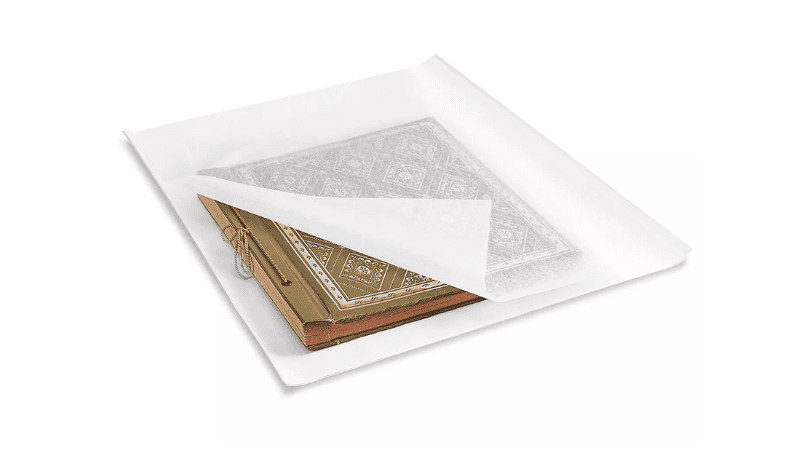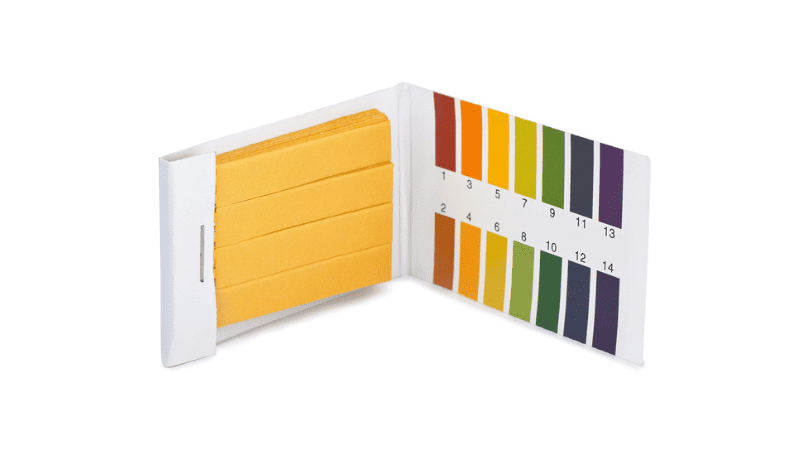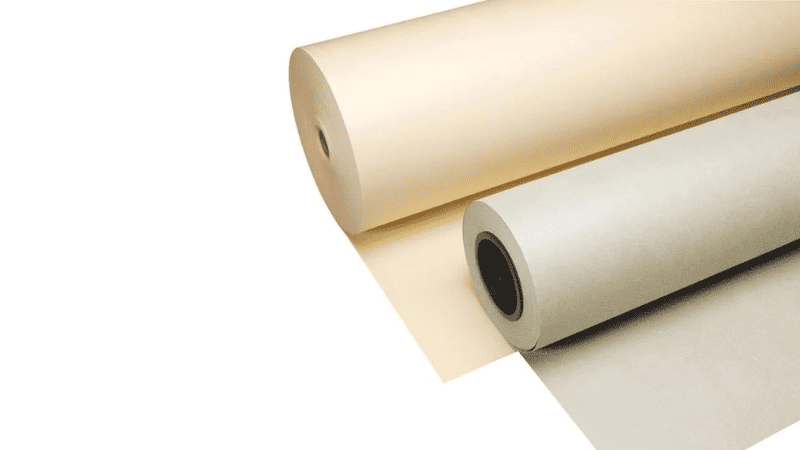Last Updated on February 28, 2025 by Packoi Team
When printing documents of great value, such as historical or legal records, or when using paper for packaging to protect precious items from chemicals, acids, heat, or acids, it is recommended to choose durable acid- and heat-free paper. This paper is designed to prevent deterioration and damage over time.
When you’re ready to have unspoiled magic, read on to learn more about acid-free paper!
What Is Acid-Free Paper?

Acid-free paper, also known as alkaline or acidic paper pulp, is a standard type of paper used in the food industry. It has a neutral pH level of 7 or higher and is often used for tissue and brand packaging.
Properties of the Paper
Acid-free paper has several important properties that make it an ideal choice for archival purposes in the storage and preservation of documents, photos, and other materials. Here are some key properties of acidity without paper:
- High Strength: It has high strength and durability, making it suitable for use in various applications such as bookbinding, photography, and printmaking.
- Smooth Finish: It has a smooth surface, which allows for sharp printing and reproduction of images.
- Light Fastness: It has high light fastness, which means that it can resist fading from exposure to sunlight over time.
- Resistance to Water Damage: It is resistant to water damage, which means it can withstand accidental spills of water without ruining the paper.
In short, It is a quality tissue paper with unique properties that make it a suitable choice of tissue paper for a wide range of printing and storage applications
5 Types of Acid-Free Paper
There are several types of acid-free paper available on the market that can be used for different purposes. Here is a list of some of the most commonly used materials for acid-free paper:
1. Aluminumized Paper
This paper has a shiny aluminum coating on one side, which makes it highly reflective. It is widely used for archival purposes as it provides excellent protection against water, light, and other forms of degradation.
2. Chrome-Treated Paper
This paper has a shiny chrome-coated surface, which makes it highly reflective. It is used for archival purposes, printing photographic prints, and other high-quality printing applications.
3. Polyethylene-Coated Paper
This paper is coated with a layer of polyethylene, which makes it highly water-resistant. It is widely used for printing book pages, manuals, and other documents that need to be stored in damp environments. Polyethylene-coated paper can be used to make mailer bags. Poly mailer bags are waterproof and can protect products well.
4. Archival Paper

This paper is made without the addition of lignin or any other acid-generating substance. It is highly pH-neutral, has excellent opacity, and is highly resistant to water, light, and other forms of degradation.
5. Synthetic-Coated Paper
Synthetic-coated paper is coated with a synthetic layer that provides protection against moisture, oil, and other spills. It has excellent opacity, excellent brightness, and excellent smoothness.
Each type of acid-free paper has its own unique characteristics and properties, and the choice of acid-free tissue paper will depend on the specific requirements and optimal conditions of the printing application. It’s important to choose the right one to protect and preserve important items like paper, photos, and marketing materials for a long time.
7 Benefits of Using Acid-Free Paper
There are many benefits associated with using acid-free paper, including:

- Extended lifespan: It is designed to resist degradation and yellowing over time, allowing documents and artifacts to be preserved for longer periods without damage.
- Color-fastness: It prevents the breakdown of pigments in printed material, ensuring vivid, true colors for a longer period of time.
- Superior quality: It is made from high-quality, high-density fibers, resulting in a smoother surface finish and increased durability.
- Improved archival storage: It is pH neutral and resistant to acid-induced degradation, making it an ideal material for the long-term storage of documents and artifacts.
- Reduced risk of mold and insect damage: It is less attractive to insects and mold than regular paper, reducing the risk of damage and degradation.
- Reduced risk of fire damage: It is less prone to fire than regular paper, reducing the risk of fire-related damage to documents and artifacts.
- Environmentally friendly: Many manufacturers of acid-free paper use recycled or sustainable materials, making this type of paper a more environmentally responsible choice.
In summary, the quality of acid-free paper is superior to regular paper, making it a premium choice for important documents and artifacts. It can be more environmentally friendly, as many manufacturers use recycled or sustainable materials, such as paper, cotton pulp, and wood-based wood pulp, in their top sheet production.
What Are the Disadvantages?
Acid-free paper, despite its benefits, does come with a few disadvantages to standard paper fibers, such as paper itself. It is important to consider these drawbacks before deciding on using them, as the standard paper is acid-free enough for your printing needs.
- Higher Cost: One drawback is that it is more expensive than regular acid paper. This is because manufacturing involves specialized techniques and materials that increase production costs.
- Limited Printing Techniques: Another drawback is that certain printing techniques may not work as effectively on its surface. Due to its unique characteristics, such as reduced porosity and smoothness, some printing methods may not produce the desired results on acid-free paper. This limitation can restrict the range of options available for tissue paper printing projects.
- Resource-Intensive Production: The production of acid-free paper requires additional resources and energy compared to conventional papers. Special measures are taken during manufacturing to ensure the pH neutrality and longevity of the paper, which adds complexity and environmental impact to the production process.
Considering these disadvantages and other items alongside the benefits will help you make an informed decision based on environmental factors, your specific requirements, and budget constraints.
Cost Comparison: Acid-Free Paper vs. Regular Paper
Acid-free paper is usually more expensive than conventional paper. The cost difference between acid-free paper and regular paper can vary significantly based on factors like quality, brand, and where you’re purchasing it.

On average, acid-free paper can be about 20% to 50% more expensive than regular paper. In some cases, especially for high-end or specialized acid-free paper intended for archival use, the cost could be double or even more than that of standard paper.
To give you a rough idea in terms of the actual cost:
- Regular paper: Prices can range widely, but for standard office or printer paper, you might expect to pay anywhere from $3 to $10 for a ream (500 sheets), depending on quality and brand.
- Acid-free paper: For a similar quantity and quality, prices might range from $6 to $20 per ream, again depending on the specific use case, quality, and brand.
The following are the main reasons why acid-free paper costs more than regular paper:
1. Production Costs
Acid-Free Paper:
- Raw Materials: Uses pulp of superior quality that has frequently been treated to eliminate lignin and any acidic components, which may include more costly commodities like cotton.
- Processing: This entails extra procedures that raise the cost, such as alkaline treatment and the inclusion of buffering agents to neutralize acids, such as calcium carbonate.
- Durability: The goal of durability and preservation, requires greater manufacturing and quality control requirements.

Regular Paper:
- Raw Materials: Wood pulp that hasn’t had a lot of processing to neutralize acidic chemicals or remove lignin is usually used.
- Processing: Reduced manufacturing costs are achieved by requiring fewer processing stages.
- Durability: Made without the need for costly longevity treatments, this product is intended for short- to mid-term use.
2. Use Case and Longevity
- Acid-Free Paper: The higher cost is often justified by its applications. It’s preferred where preservation of written, printed, or drawn materials is crucial, such as in legal documents, archival records, and fine art prints.
- Regular Paper: More cost-effective for everyday use where longevity is not a primary concern, including office printing, notebooks, and newspapers.
3. Environmental Impact and Sustainability
- While not always the case, the production of acid-free paper can sometimes involve more sustainable practices, as it’s often geared toward a market that values eco-friendliness. However, these practices can also contribute to the higher cost. Regular paper, especially when produced from non-sustainable forestry or without recycling initiatives, might be cheaper but also pose greater environmental concerns.
It’s crucial to remember that costs could change depending on the seller, the state of the market, and the type of paper (such as printing, art, or archival). Because of its increased durability, the more involved manufacturing process needed to remove acid, and the use of better raw materials, acid-free paper costs more.
These factors make acid-free paper a preferred choice for applications where longevity and preservation of the content are crucial, such as legal documents, archival records, and art prints.
In conclusion, the choice between acid-free and regular paper boils down to balancing the need for longevity and preservation against cost considerations.
4 Industries and Applications of Acid-Free Paper
Acid-free paper, made from wood pulp, finds extensive use in various industries due to its unique properties. Let’s explore some key applications of acidic paper:

1. Publishing
In the publishing industry, acid-free paper is a popular choice for producing books, magazines, and archival materials. Its pH-neutral composition, combined with the use of tissue paper, ensures longevity and prevents deterioration over time.
2. Art and Photography
The art and photography industry heavily relies on acid-free paper to preserve valuable prints, drawings, and photographs. By using it as a base material, artists can safeguard their creations from yellowing or fading.
3. Libraries, Museum, and Archives
Libraries, museums, and archives consider acid-free paper indispensable for preserving historical documents and manuscripts. The durability of this specialized paper helps maintain the integrity of these irreplaceable artifacts for future generations.
4. Packaging
Acid-free paper also serves an important purpose in packaging sensitive items such as jewelry, electronics, and collectibles. Acid-free paper’s non-reactive nature provides a protective layer that prevents potential damage caused by acidic materials. The acid-free paper acts as a barrier, shielding against any harm that could be caused by these substances.
Comparison: Acid-Free Paper vs. Archival Paper
Both acid-free paper and acid-free archival paper are commonly designed for the long-term preservation of documents and artifacts. However, there are some significant differences between the two materials that may influence your choice of archival quality for specific long-term preservation needs.
1. Duration
Archival paper is designed to last for hundreds of years, while acid-free paper is typically designed for preservation for ten to one hundred years. If you have documents or artifacts that require extended, long-term preservation, archival paper is a more durable, acid-free paper than tissue paper and may be the better choice.
2. Acid Content
Archival paper has a shallow acid content, typically less than 0.5% acetic acid. This makes it ideal for preserving materials such as paper that are vulnerable to acidic paper, such as delicate items such as photographic prints. Acid-free paper, on the other hand, can have an acid content of up to 4%.

3. Colorfastness
The archival paper has excellent colorfastness, meaning that the pigments used in printing will not fade over time. Acid-free paper can also have good colorfastness but may not be as effective at preserving the color of printed materials over the long term.
4. Handling
Archival paper is typically produced on thinner, more brittle, and more fragile paper, making it more difficult to handle and transport than acid-free paper.
5. Cost
Archival paper is generally more expensive than acid-free paper due to its longer lifespan and higher standards for production and handling.
How Do You Identify Acid-Free Paper?
Acid-free paper is usually determined by the paper manufacturer’s certification that the paper used is durable and meets specific standards for the acid content of the natural part of the paper. This certification is usually printed on the package or on paper. To identify it, you can also perform the following tests:
1. Labels and Certifications

Look for labels or certifications indicating that the paper is acidity-free, archival grade, or meets an international standard of quality. These labels provide assurance that the paper is acid-free or has been treated to resist acidity. To identify them, you should look for the following certification marks:
- The International Paper and Paperboard Packaging Council: This certification is also widely recognized and ensures that the paper meets a high standard for acid-free production. This certification ensures that the paper meets specific standards for paper quality and acid-free production.
- The British Standards Institution (BSI): BSI certification is the UK production standard. BSI certification ensures that the paper meets specific standards for acid-free production but is less widely recognized than the AFPI or IPBPC certifications.
2. pH Level Testing
- Check the pH level of the paper using pH testing pens or strips available at art supply stores.
- Acid-free paper typically has a neutral or slightly alkaline pH level, usually between 7 and 8.5.
3. Color Examination
- Examine the color of the paper; true acid-free papers are usually bright white rather than yellowish.
- Acidic papers tend to yellow over time, while acid-free papers maintain their original brightness.
4. Expert Consultation
You can also consult a professional or protection specialist. They have a wealth of knowledge and experience in identifying materials and can give you professional advice and help with your printing.
Conclusion
In this comprehensive blog post, we explore what acid-free paper is, providing insights on identifying acid-free sheets of paper to ensure you can make an informed decision when buying based on your business needs.
Discover the Perfect Printing for Your Business with Packoi Printing
With Packoi Printing’s expertise in the papermaking process delivering high-quality printing solutions, you can trust us to deliver the perfect printing solution according to your requirements. Whether you need to print brochures, brochures, or other marketing materials, our team is here to help you every step of the way.
Contact us today! Printing your perfect solution




